Building Resilience Through Chaos Engineering on AWS EKS
Chaos engineering practices using Chaos Mesh on Amazon EKS to build more resilient cloud-native applications.
System failures aren’t a matter of “if” but “when.” I learned this the hard way during a cascading failure that started with one innocent microservice update.
Your application might look bulletproof in staging, but production has a way of revealing dependencies you never knew existed. That “reporting-only” API your service calls? It’s in the critical path. The shared Redis cache? Everyone’s using it. When one service gets slow, everything downstream suffers.
Here’s the thing - what if you could experience all these failures during office hours, with coffee in hand, in a controlled sandbox where you can’t nuke production? That’s chaos engineering done right.
Netflix pioneered this with Chaos Monkey, but they started small, controlled, and safe. We’re doing the same.
Instead of waiting for failures to surprise us, chaos engineering proactively introduces controlled failures to:
• Find hidden weaknesses before they cause real outages
• Build confidence in recovery procedures through practice
• Improve incident response by creating muscle memory for failure scenarios
When that database connection fails in production, your team won’t panic - they’ve handled it before.
Infrastructure as Code Approach
We’re using Terraform for everything. Reproducible chaos environments that you can spin up, experiment with, and tear down without worrying about leftover resources.
Lessons from Implementation
Building this took longer than expected because of three critical decisions I got wrong initially.
Container Runtime Reality Check I assumed Docker everywhere, but Amazon Linux 2023 uses containerd by default. Chaos Mesh needs direct access to container runtime sockets, so this matters. Always check your runtime before installing chaos tools.
Spot Instances for Chaos Labs Using Spot instances might seem risky for reliability testing, but it’s perfect. These instances can vanish at any moment, adding real chaos to your chaos. Plus, 90% cost savings means you can run extensive experiments without infrastructure bills eating your budget.
For production chaos testing though, stick with on-demand instances. Having AWS reclaim your Spot capacity mid-experiment defeats the purpose.
IRSA for Secure Experiments Skip embedded credentials completely. IAM Roles for Service Accounts (IRSA) gives you fine-grained control over what experiments can access which AWS resources. Essential when chaos experiments need CloudWatch integration or AWS API access.
Demo Application Architecture
Instead of a toy single-service app, we need something that breaks in interesting ways. Our three-tier system that mirrors microservices pain points.
Each tier is designed to fail differently and teach us something specific:
Frontend Two nginx replicas, not more, not less. This gives us basic high availability but lets us see load distribution effects during failures. When backend services get slow, nginx timeout configs become critical - too short and users see errors, too long and user experience suffers.
This is where user pain shows up first. Kill backend pods or add network delays, and the frontend reveals whether your system fails gracefully or just passes errors straight to users.
Backend API Three Apache httpd replicas create interesting scenarios. Kill one, you still have 66% capacity. This mirrors real production where some capacity dies but service continues.
httpd might seem old-school for a modern API, but it’s perfect for predictable chaos experiments. Easy to configure response times, simulate load patterns, and test service discovery behaviors. In production, this would be your actual API services.
Database Single Redis instance. Yes, this violates every production best practice, but that’s the point. This single point of failure creates cascading scenarios that reveal how your application handles data layer problems.
When we network-partition this database, both frontend and backend must gracefully handle data access failures. Does your service provide degraded functionality, or does it just crash? This design forces proper connection pooling, retry logic, and graceful degradation.
Chaos Engineering Experiments
We’re not randomly breaking things. Each experiment targets specific failure modes you’ll see in production. Start simple, build confidence, then move to complex scenarios.
Technical Stack
- Infrastructure: AWS EKS, Terraform
- Chaos Platform: Chaos Mesh
- Container Runtime: containerd
- Monitoring: kubectl, curl, custom scripts
- Languages: YAML, Bash, HCL
Prerequisites
- EKS cluster (1.30-1.31) with containerd runtime
- kubectl configured
- Helm 3.8+ installed
- AWS CLI configured with appropriate IAM permissions
Important: EKS uses containerd at
/run/containerd/containerd.sockby default. This socket path is critical for Chaos Mesh daemon operations.
Quick Setup
1. Deploy Infrastructure
Using either of the two options:
Quick Cluster with eksctl:
# Create an EKS cluster with containerd (check supported versions: aws eks describe-addon-versions)
eksctl create cluster \
--name chaos-engineering-lab \
--version 1.31 \
--region us-east-1 \
--nodegroup-name chaos-workers \
--node-type t3.medium \
--nodes 3 \
--nodes-min 2 \
--nodes-max 4 \
--managed \
--spot \
--node-ami-family AmazonLinux2023 # Pin AL2023 for containerd
# Note: Verify EKS version support before creating cluster
# aws eks describe-addon-versions --kubernetes-version 1.31
Using Terraform:
git clone https://github.com/ToluGIT/chaos-mesh-eks.git
cd terraform/
terraform init && terraform apply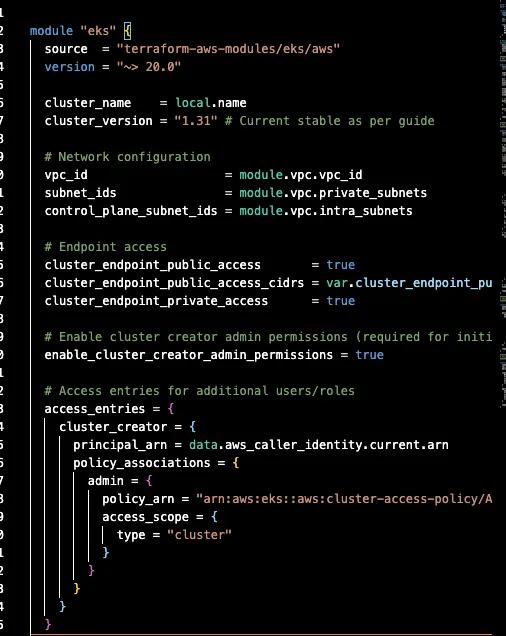

Connect to Your Cluster:
# Update kubeconfig
aws eks update-kubeconfig --region us-east-1 --name chaos-engineering-lab
# Verify you're connected
kubectl get nodes
# Check the containerd socket path (this is important!)
kubectl get nodes -o wide
# Note: EKS nodes use containerd at /run/containerd/containerd.sock
2. Create Isolated Sandbox Environment
First, let’s create an isolated sandbox environment for our chaos experiments:
# Create the chaos-sandbox namespace for our test applications
kubectl create namespace chaos-sandbox
# Label it clearly so everyone knows what it's for
kubectl label namespace chaos-sandbox purpose=chaos-experiments
kubectl label namespace chaos-sandbox environment=sandbox
kubectl annotate namespace chaos-sandbox chaos-mesh.org/inject=enabled3. Install Chaos Mesh with Security Controls
# Create the chaos-mesh namespace for the chaos infrastructure
kubectl create namespace chaos-mesh
# Install Chaos Mesh with containerd configuration (pin version for reproducibility)
helm repo add chaos-mesh https://charts.chaos-mesh.org
helm repo update
helm install chaos-mesh chaos-mesh/chaos-mesh \
--namespace chaos-mesh \
--version 2.7.3 \
--set chaosDaemon.runtime=containerd \
--set chaosDaemon.socketPath=/run/containerd/containerd.sock \
--set controllerManager.enableFilterNamespace=true \
--set controllerManager.targetNamespace=chaos-sandbox
# Note: Check latest compatible versions at https://artifacthub.io/packages/helm/chaos-mesh/chaos-mesh
# Chaos Mesh 2.7.x supports Kubernetes 1.25-1.31
# Verify installation
kubectl get pods -n chaos-mesh -w
4. Implement Namespace Safety Fence (Curated RBAC)
This keeps chaos experiments centralized in chaos-mesh while limiting impact to chaos-sandbox only.
# Ensure the sandbox namespace exists
kubectl get namespace chaos-sandbox || kubectl create namespace chaos-sandbox
# Create the service account used for dashboard auth and API calls
kubectl create serviceaccount chaos-manager -n chaos-sandbox
# Apply curated RBAC
kubectl apply -f rbac/chaos-manager-cluster-role.yaml
kubectl apply -f rbac/chaos-sandbox-manager-role.yaml
kubectl apply -f rbac/chaos-rbac-bindings.yaml
# Generate a limited-scope token (2 hours duration)
kubectl create token chaos-manager -n chaos-sandbox --duration=2hNote: Chaos Mesh runs in the chaos-mesh namespace (control plane), but experiments only affect workloads in the chaos-sandbox namespace thanks to RBAC and the target namespace filter.
This configuration ensures that: • Chaos CRs are created/read in chaos-mesh, but selectors limit actions to chaos-sandbox • The service account only has write in chaos-sandbox and read-only where needed • The dashboard has the minimum visibility to work well without cluster-admin
5. Deploy Test Application to Sandbox
# Deploy our multi-tier application to the chaos-sandbox namespace
kubectl apply -f enhanced-test-app.yaml -n chaos-sandbox
# Verify deployment
kubectl get pods -n chaos-sandbox
kubectl get services -n chaos-sandbox6. Set Up Dashboard Access with Limited Permissions
# Forward the Chaos Mesh dashboard
kubectl port-forward -n chaos-mesh svc/chaos-dashboard 2333:2333
# Access at http://localhost:2333When you visit http://localhost:2333, use the limited-scope token for ServiceAccount chaos-manager generated in step 4. The dashboard will show that you can only create experiments targeting the chaos-sandbox namespace - this is our safety fence in action!

The Chaos Mesh dashboard provides visual experiment management with:
• Point-and-click experiment creation
• Experiment monitoring
• Historical experiment analysis
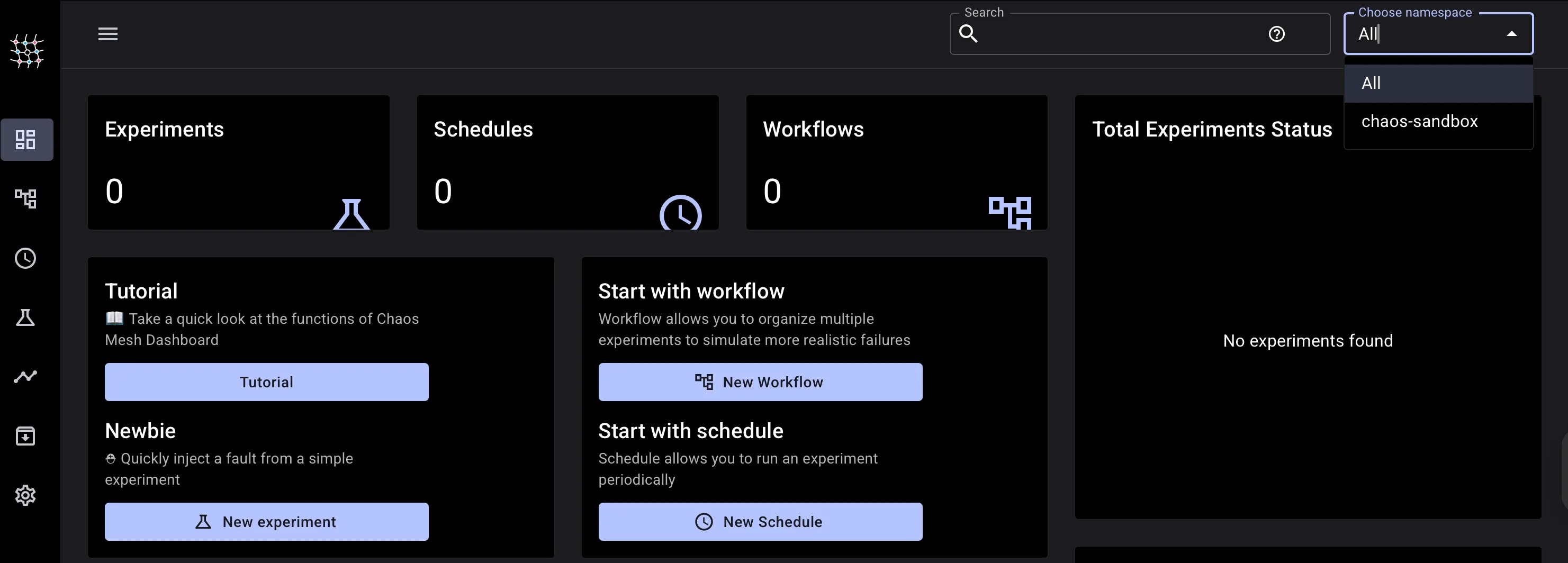
Monitoring & Observability
Enable Container Insights in CloudWatch before running experiments. You need baseline metrics to understand what “normal” looks like versus “chaos.”
Container Insights Metrics: • CPU Usage: pod_cpu_utilization - spikes when pods restart after kills
• Memory Usage: pod_memory_utilization - pressure during resource exhaustion
• Pod Restarts: pod_number_of_container_restarts - tracks chaos experiment impact
• Node Resources: node_cpu_utilization, node_memory_utilization - cluster health
Application Response Times (via ALB/CloudWatch): • ALB Response Time: AWS/ApplicationELB/TargetResponseTime - user-facing latency
• ALB Request Count: AWS/ApplicationELB/RequestCount - traffic patterns during failures
Sample CloudWatch Insights Query:
fields @timestamp, pod_name, pod_cpu_utilization, pod_memory_utilization
| filter namespace_name = "chaos-sandbox"
| stats avg(pod_cpu_utilization), max(pod_memory_utilization) by pod_name
| sort @timestamp descSet up alarms to auto-stop experiments if error rates hit dangerous levels. Chaos should teach, not break production.
Now let’s deploy our test application:


1. Pod Failure Testing
Start here. Pod failures happen constantly in production - during deployments, node maintenance, or simple container crashes. This experiment is predictable and gives immediate results. You’ll see instantly whether your application handles pod loss gracefully or passes errors to users.
API Version Note: All experiments use
chaos-mesh.org/v1alpha1API version, compatible with Chaos Mesh 2.6+ and Kubernetes 1.25-1.31.
apiVersion: chaos-mesh.org/v1alpha1
kind: PodChaos
metadata:
name: basic-pod-kill
namespace: chaos-mesh
annotations:
chaos.alpha.kubernetes.io/experiment: "pod-resilience-test"
spec:
action: pod-kill
mode: one # Kill only one pod at a time
duration: "60s" # Run for 1 minute to observe recovery
selector:
namespaces:
- chaos-sandbox
labelSelectors:
app: backend-api # Target our backend services
# The killed pod should be recreated automatically by the DeploymentChaos mesh provides multiple ways to start an experiment, let’s explore using the dashboard by adding a YAML file directly
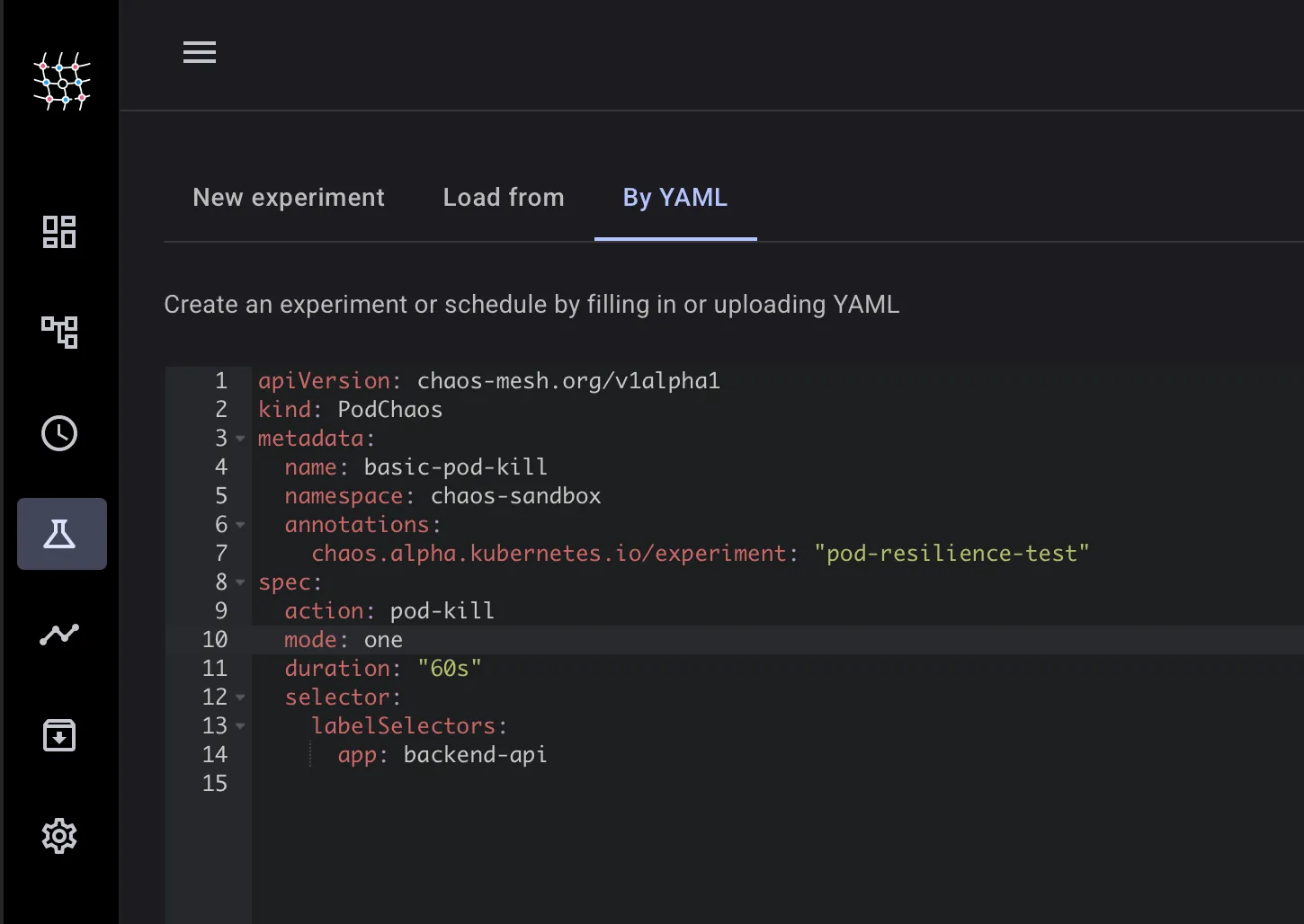
It fills the experiment sections with the details mentioned within the yaml manifest 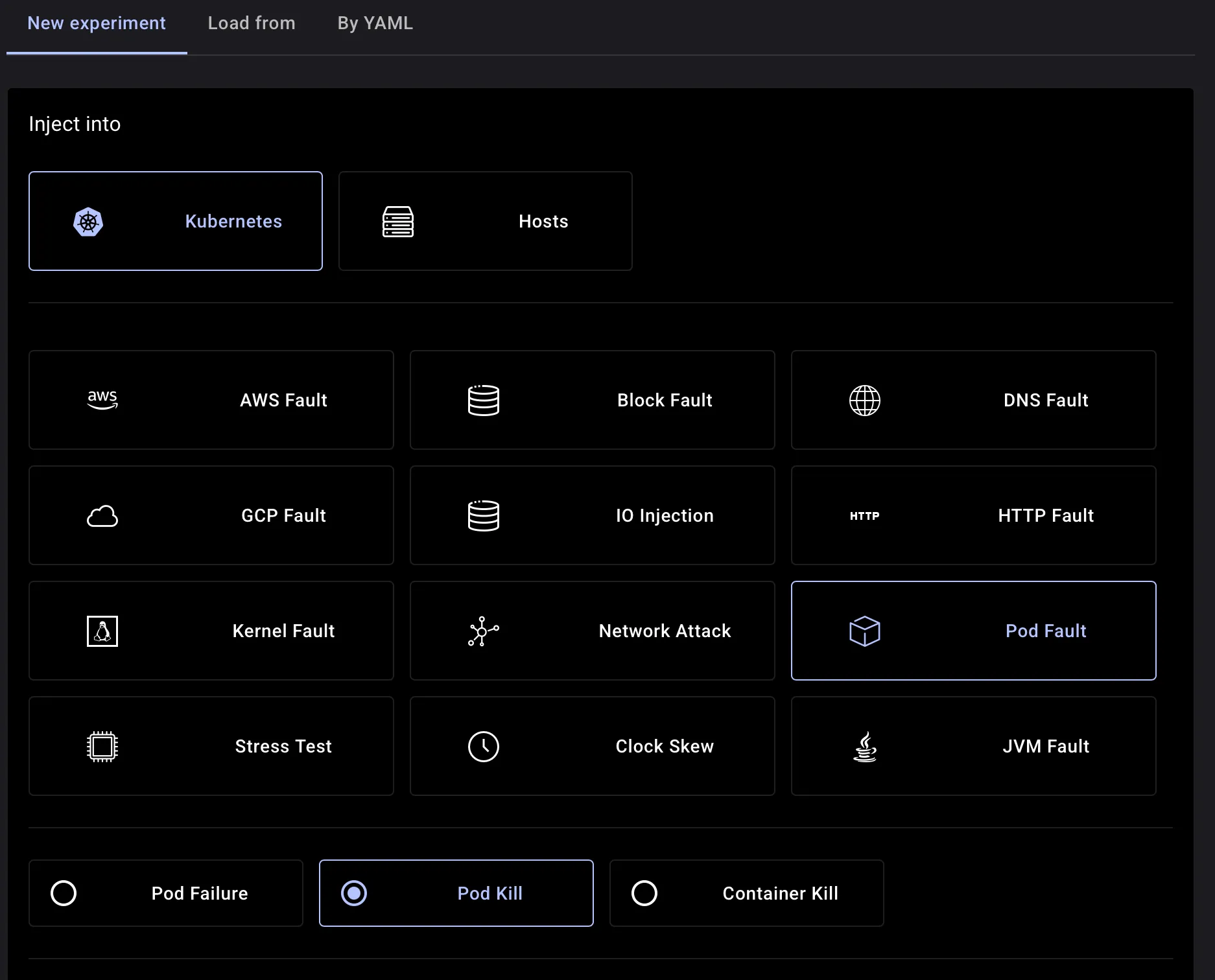
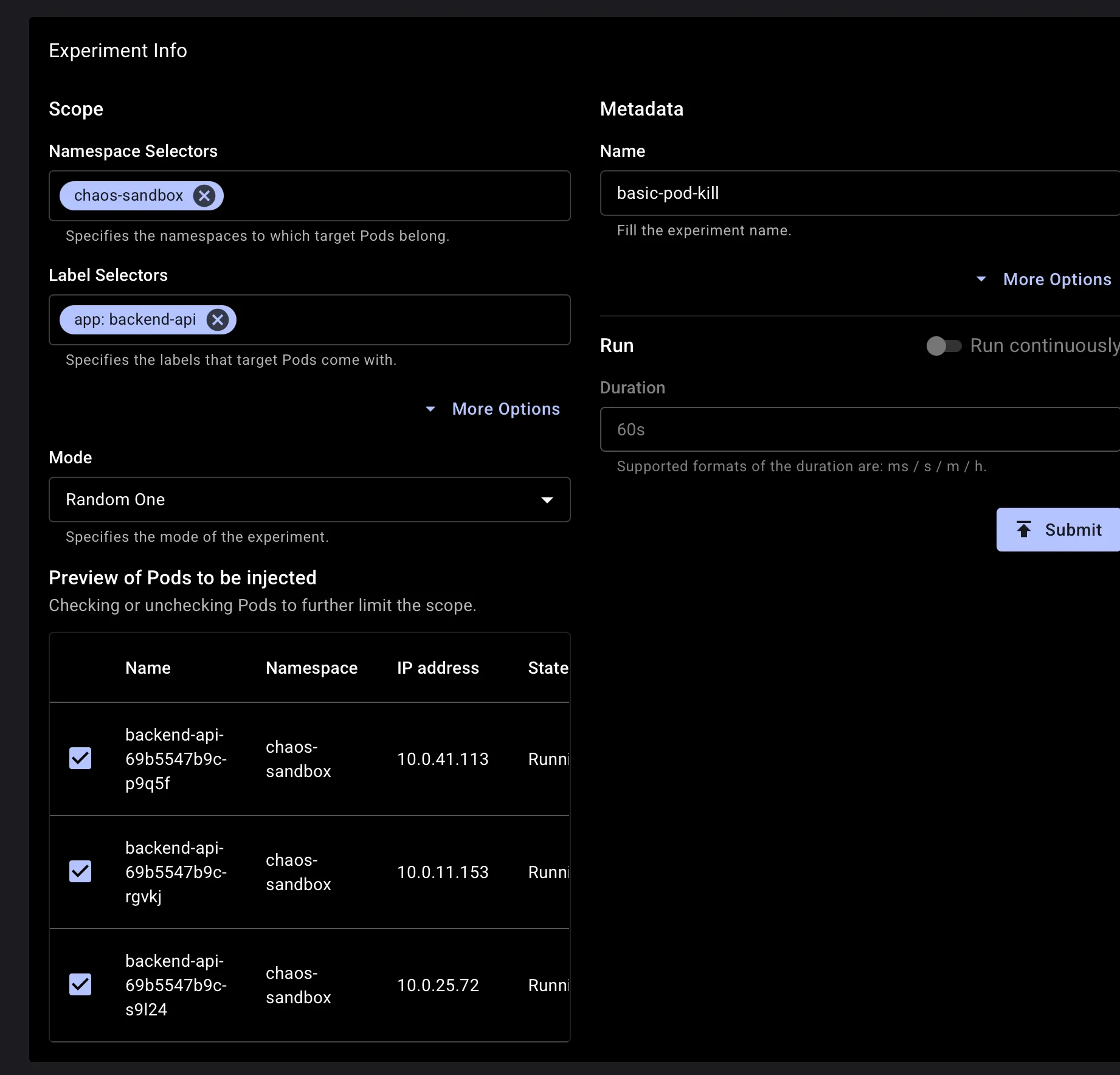
After submitting the experiment, you can monitor its progress directly in the dashboard: 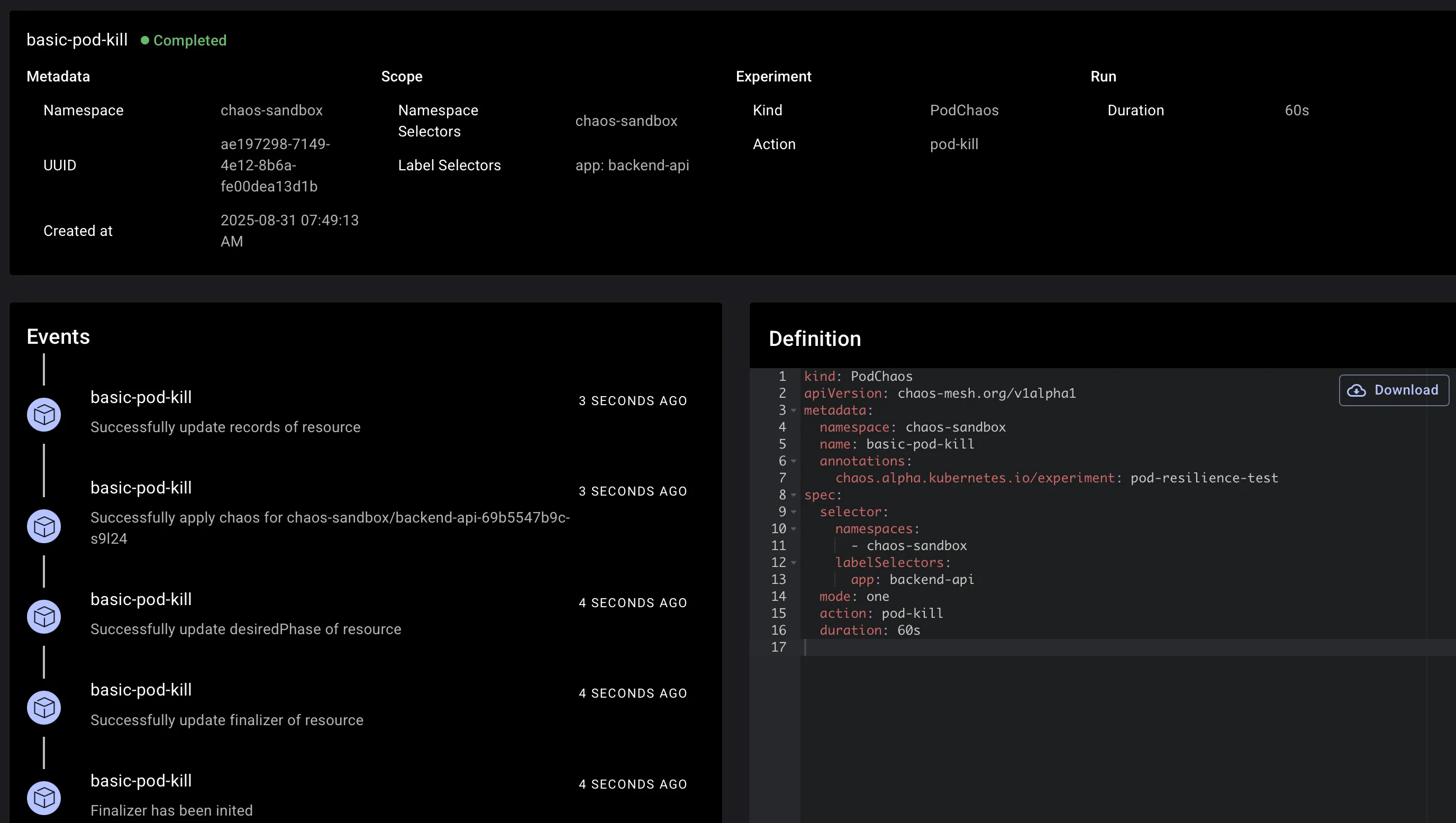
What You’ll Observe:

The targeted pod terminates immediately. Kubernetes creates a replacement within seconds. During this window, watch whether your frontend still serves requests or users get errors.
With three backend replicas, losing one shouldn’t disrupt service. You might see temporary response time increases as remaining pods handle full load - that’s normal.
Most critical: observe replacement pod startup time. Slow container startup means longer user impact. This often reveals the need for optimized startup times and proper health checks.
Why This Matters: This simulates rolling deployments (where Kubernetes terminates old pods), node maintenance, and container crashes. You’re testing whether application state is properly externalized and stateless design works.
2. High Latency API Simulation
External APIs get slow, causing cascading delays. This happens more than you think: third-party services degrade, database queries slow down, or network conditions change.
apiVersion: chaos-mesh.org/v1alpha1
kind: NetworkChaos
metadata:
name: api-high-latency
namespace: chaos-mesh
annotations:
chaos.alpha.kubernetes.io/experiment: "high-latency-api"
spec:
action: delay
mode: all # Affect all frontend pods
duration: "120s" # 2 minutes for observation
selector:
namespaces:
- chaos-sandbox
labelSelectors:
app: frontend-app # Target frontend pods
delay:
latency: "500ms" # Half-second delay - users notice this
correlation: "90" # 90% of packets affected (realistic)
jitter: "100ms" # ±100ms variance for realism
direction: to # Only outgoing traffic (to backend)
target:
mode: all
selector:
namespaces:
- chaos-sandbox
labelSelectors:
app: backend-api # Only affect traffic to backendVerify its execution and status:
kubectl -n chaos-mesh describe networkchaos api-high-latency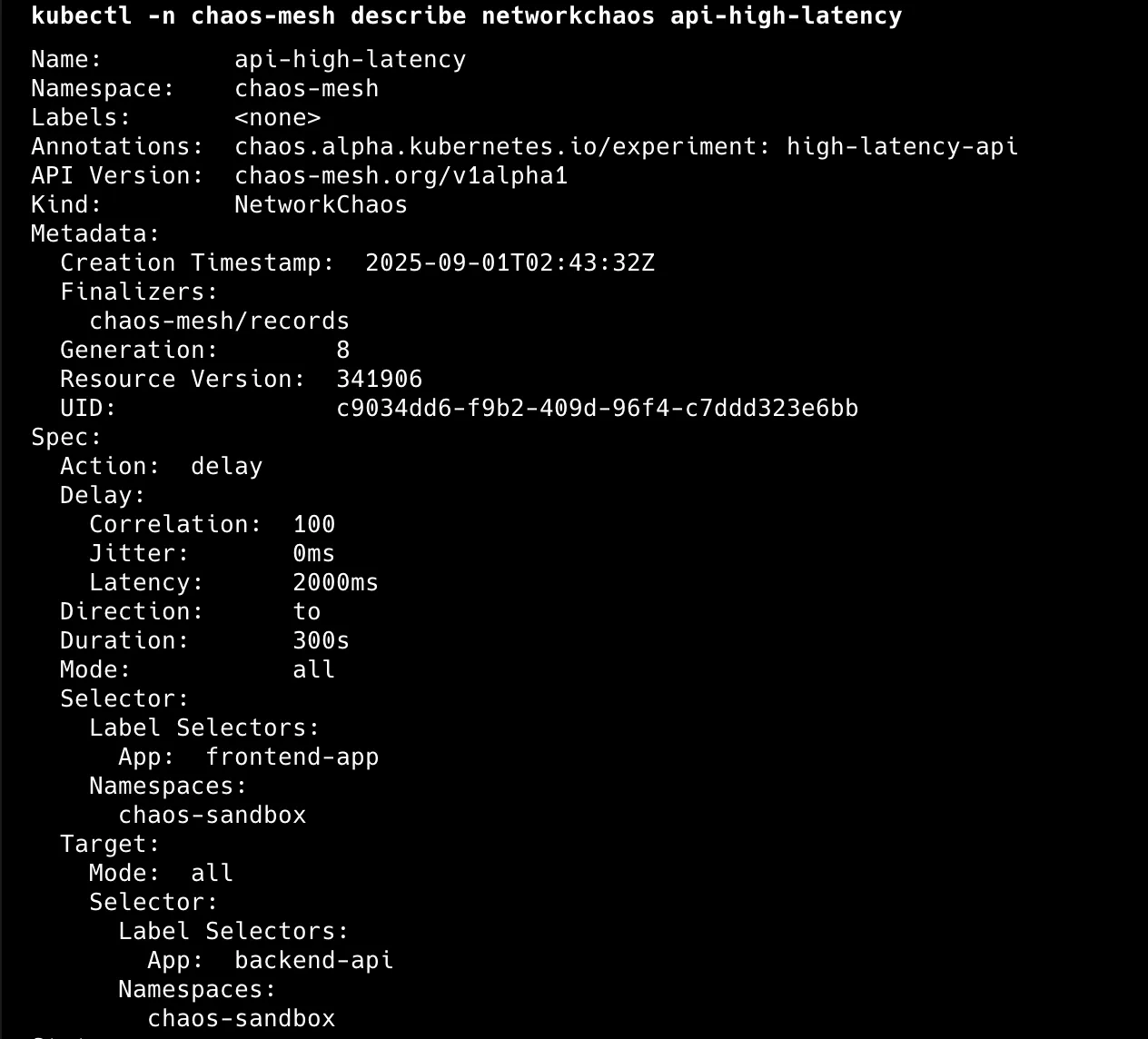
Also from dashboard:
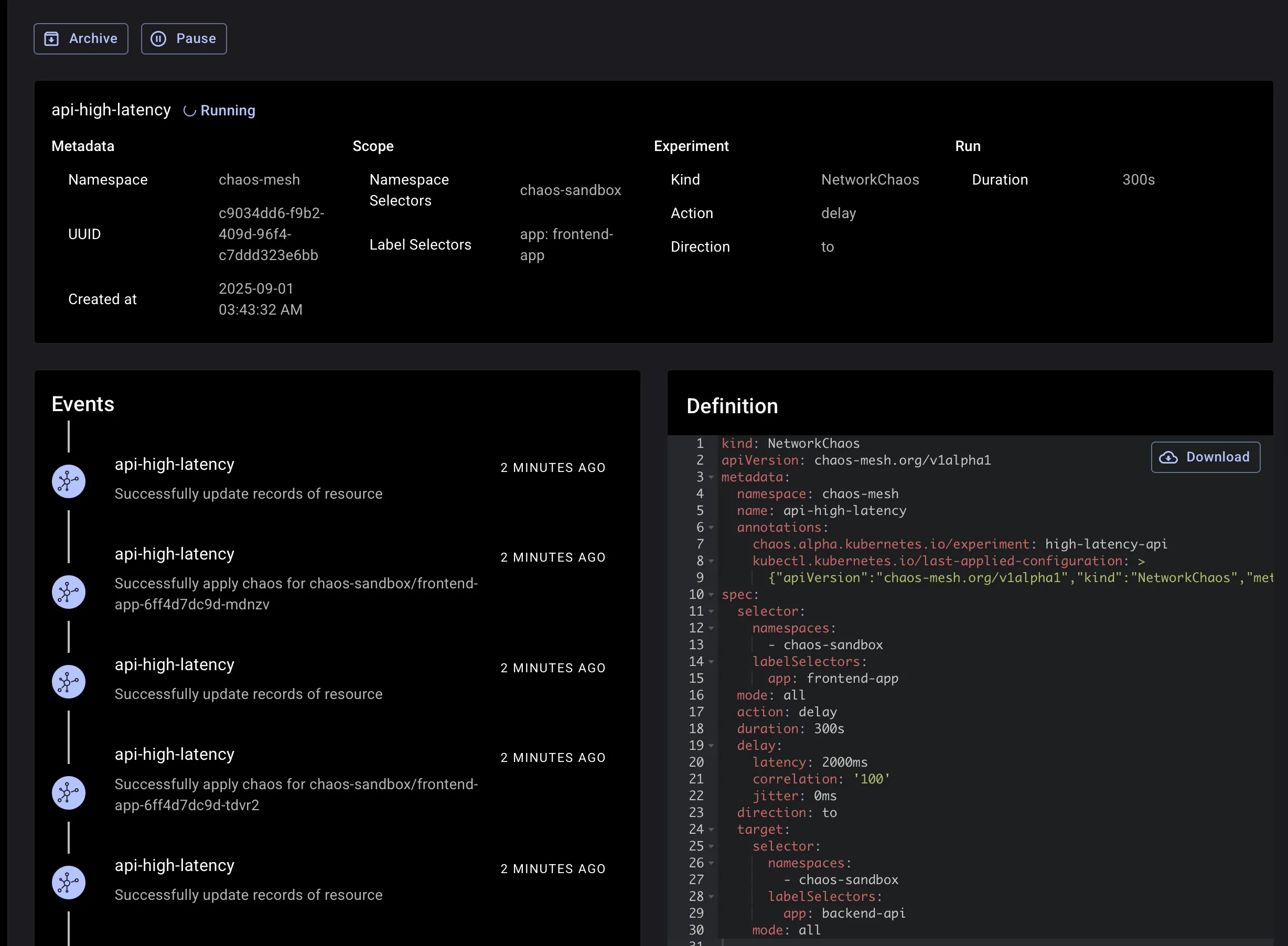
End-to-end latency increase on /api/: This proves the delay “to backend” is applied.
kubectl -n chaos-sandbox port-forward svc/frontend-service 8080:80 & PID=$!before

after running

3. Packet Loss Scenarios
Cloud networks aren’t reliable. 15% packet loss might sound extreme, but I’ve seen worse during outages.
apiVersion: chaos-mesh.org/v1alpha1
kind: NetworkChaos
metadata:
name: packet-loss-scenario
namespace: chaos-mesh
annotations:
chaos.alpha.kubernetes.io/experiment: "packet-loss"
spec:
action: loss
mode: one # Affect one backend pod at a time
duration: "90s" # 1.5 minutes observation window
selector:
namespaces:
- chaos-sandbox
labelSelectors:
app: backend-api
loss:
loss: "15" # 15% packet loss
correlation: "50" # 50% correlation
direction: both # Affect both request and response trafficfor i in {1..10}; do
echo "Request $i:"
curl --max-time 5 -sS -o /dev/null -w "Response time: %{time_total}s, HTTP code: %{http_code}\n" http://localhost:8080/api/ || echo "FAILED"
sleep 1
donebefore
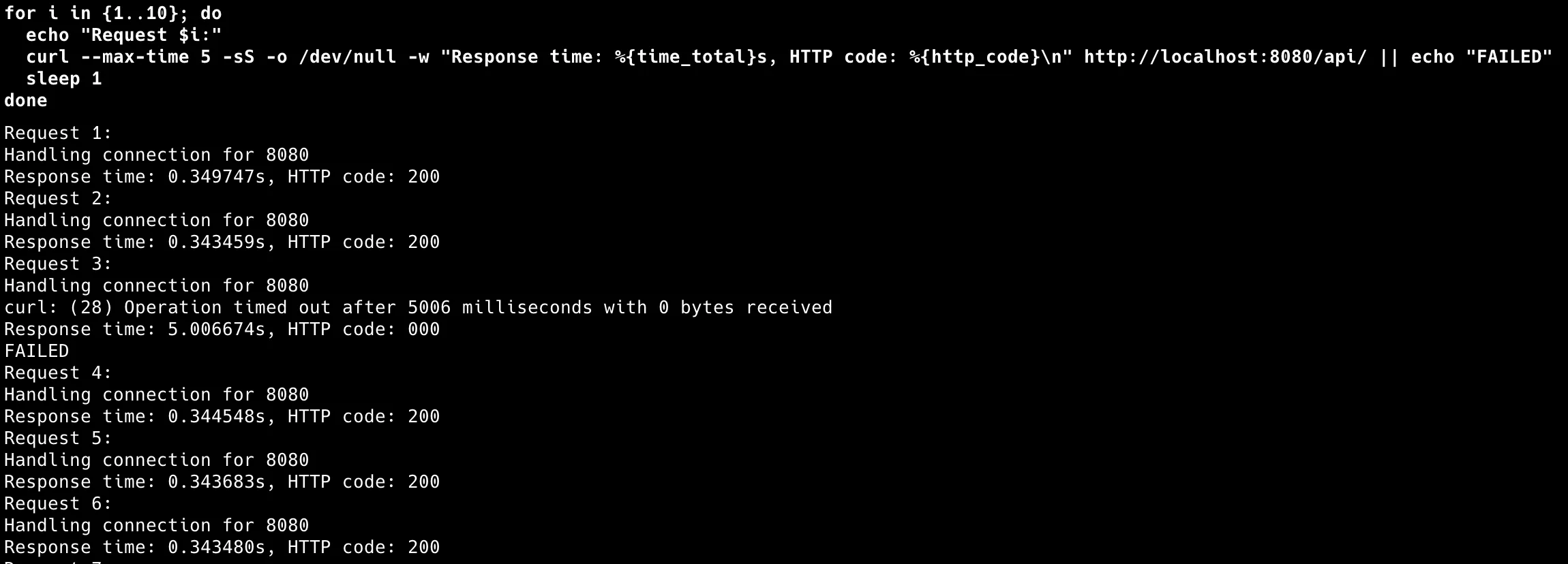
after
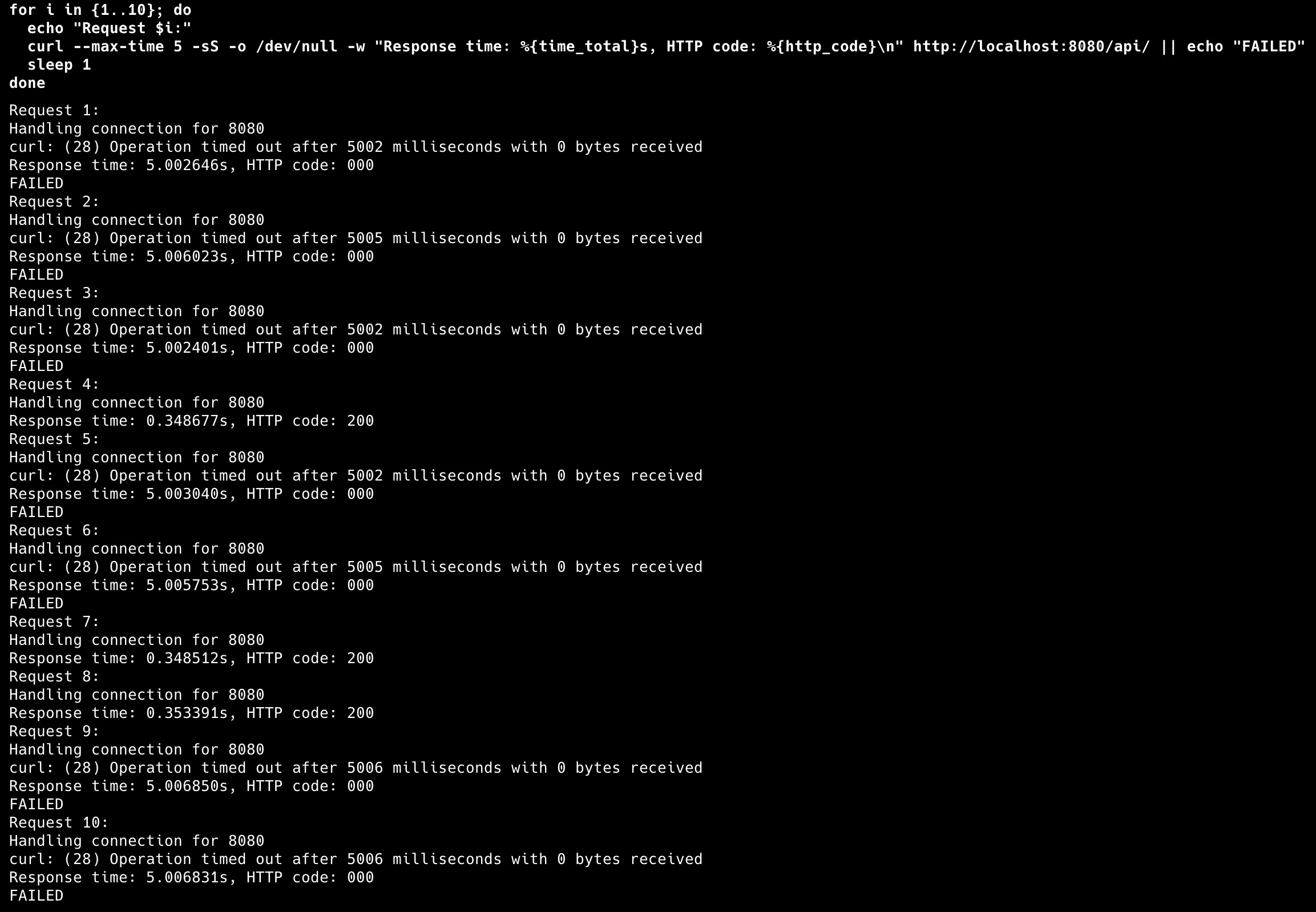
Results show the reality of network failures: • Successful requests: Response time: 0.348s, HTTP code: 200
• Failed requests: Operation timed out after 5002ms, HTTP code: 000
4. Network Partitioning (Split Brain)
Complete network isolation. This is the nightmare scenario where services can’t talk to each other at all.
apiVersion: chaos-mesh.org/v1alpha1
kind: NetworkChaos
metadata:
name: database-partition
namespace: chaos-mesh
annotations:
chaos.alpha.kubernetes.io/experiment: "database-isolation"
spec:
action: partition
mode: all # Isolate all database instances
duration: "120s" # Short duration - this breaks the app
selector:
namespaces:
- chaos-sandbox
labelSelectors:
app: database # Target database pods
direction: both # isolate database
target:
mode: all
selector:
namespaces:
- chaos-sandbox
labelSelectors:
app: backend-api # From backend API podsResults are brutal but expected:
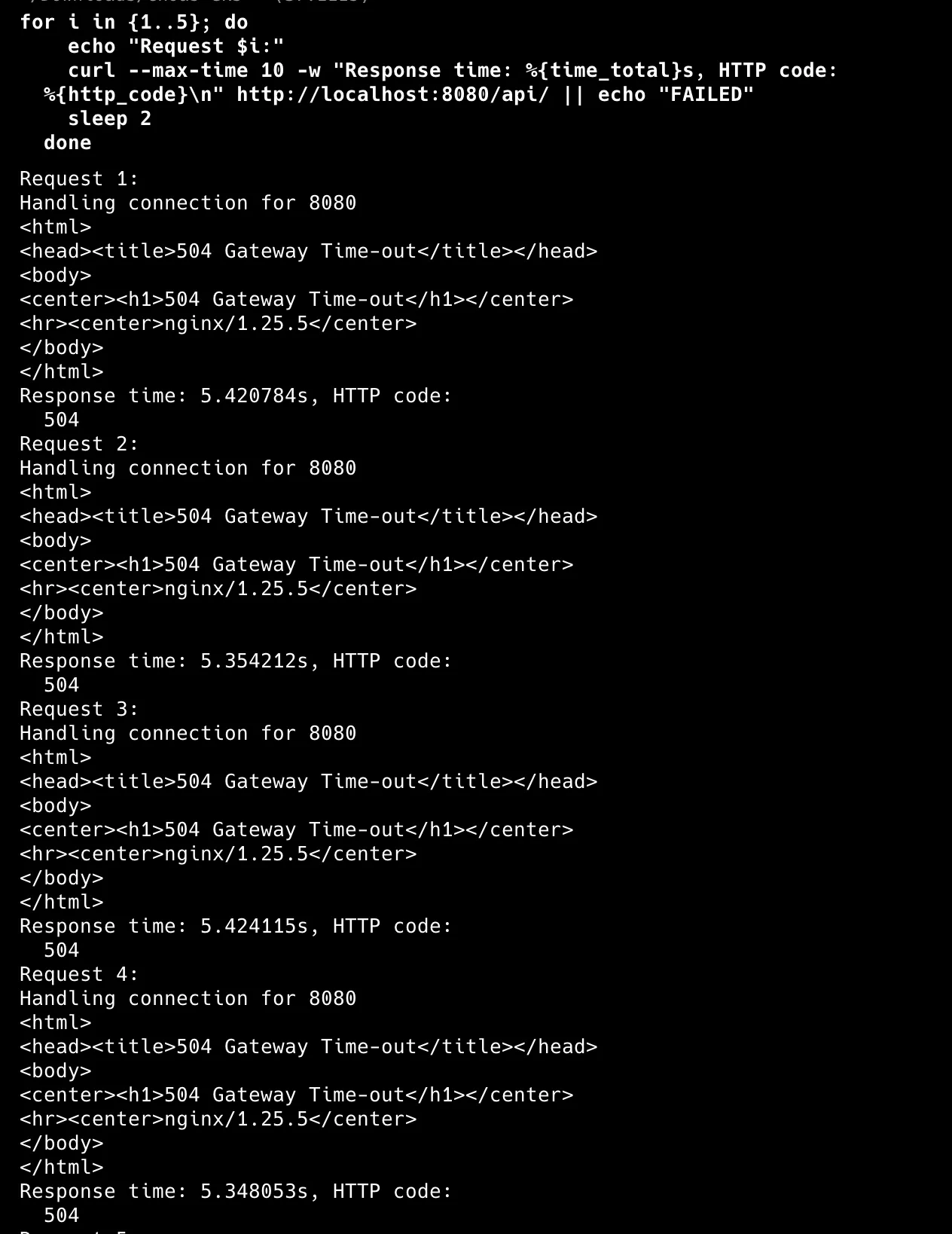
• 100% failure rate: All requests fail or timeout
• Long response times (up to 10s) as backend can’t reach database
• Complete application breakdown: total database outage simulation
5. Progressive Degradation
Systems rarely fail instantly. They slow down gradually as load increases, dependencies degrade, or resource pressure builds.
apiVersion: chaos-mesh.org/v1alpha1
kind: NetworkChaos
metadata:
name: progressive-delay
namespace: chaos-mesh
annotations:
chaos.alpha.kubernetes.io/experiment: "progressive-degradation"
spec:
action: delay
mode: all # Affect all backend pods
duration: "300s" # 5 minutes total observation
selector:
namespaces:
- chaos-sandbox
labelSelectors:
app: backend-api
delay:
latency: "50ms" # Start with small delay
correlation: "100" # Affect all traffic for consistency
jitter: "10ms" # Small jitter in intervals
direction: both # Affect both directions
# For progressive testing, you'd run multiple experiments
# with increasing latency values: 100ms -> 500ms -> 1000ms -> 3000msRun multiple experiments with increasing latency: 100ms, 500ms, 1000ms, 3000ms. Each phase reveals different threshold points where user experience breaks.
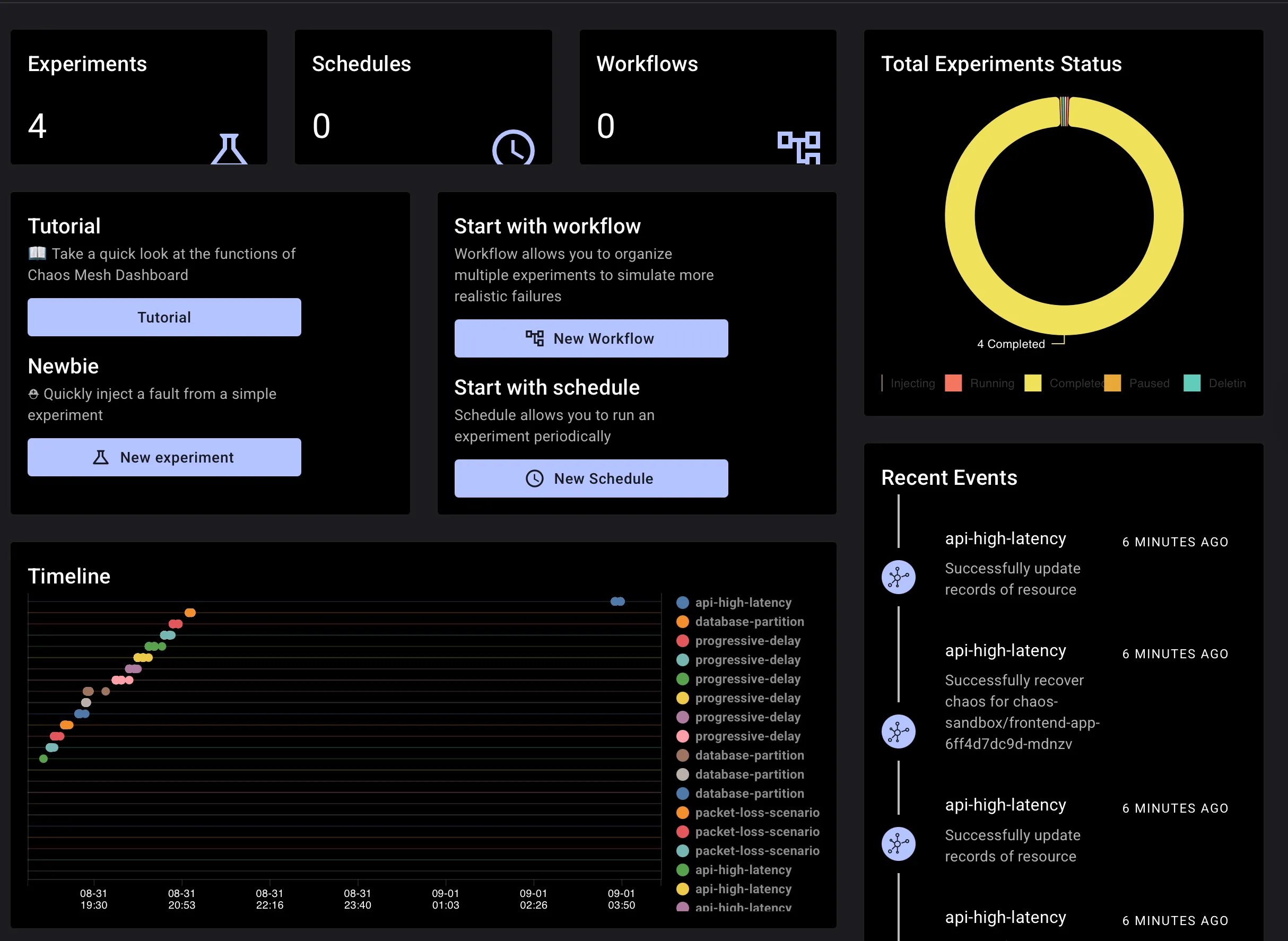
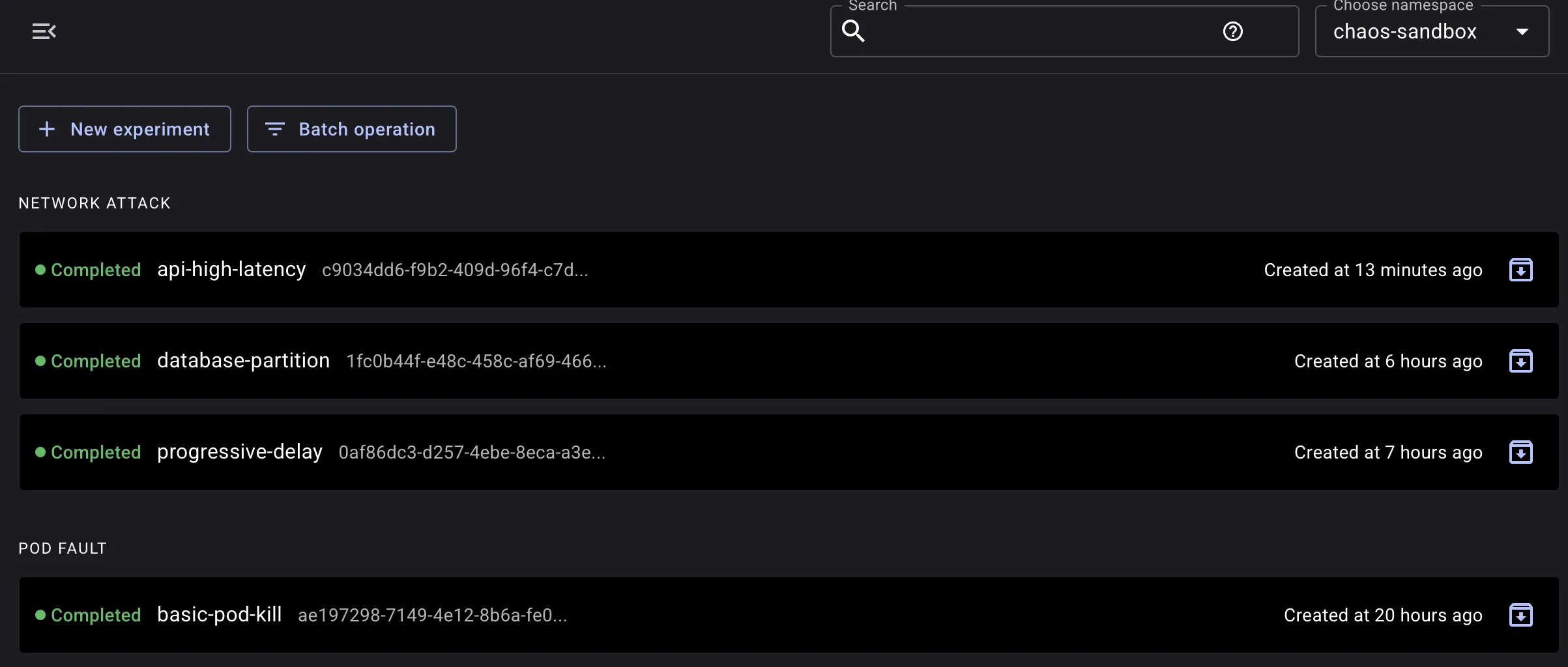
Best Practices from Implementations
Start Ridiculously Small Begin with 30-60 second experiments affecting one pod. I once jumped into a 10-minute network partition without preparation, and the team panicked thinking we had a real outage. Starting small teaches blast radius and builds trust.
Baseline Everything
Run monitoring scripts multiple times across different periods before any chaos. That 200ms response time during chaos - is it from your experiment or normal variance? Understanding baseline performance is crucial for accurate chaos assessment.
Auto-Termination is Non-Negotiable Set explicit durations and verify they work. I had one experiment run overnight because duration limits failed. Now I test termination in staging first. Chaos you can’t control isn’t chaos engineering, it’s just breaking things.
Document Immediately Create a simple log: what you tested, what happened, what you learned. Three weeks after our database chaos testing, production had a similar connectivity issue. Our experiment notes helped fix it in minutes instead of hours. These become your incident playbook.
Production Chaos Needs Safeguards Rollback procedures ready. Stakeholders informed. “Stop everything” mechanism tested. Production chaos isn’t reckless, it’s controlled testing with multiple safety nets. Every experiment needs explicit approval and monitoring.
Chaos Engineering going further
AWS FIS Integration The natural evolution is AWS Fault Injection Simulator: native chaos service with built-in safeguards. Instead of managing Chaos Mesh, orchestrate experiments through FIS. Stop EC2 instances, throttle EBS volumes, simulate AZ failures. It integrates with Systems Manager and CloudWatch for scheduling and auto-rollback.
GitOps Chaos Pipeline Treat chaos experiments as infrastructure code. Commit experiment configs to Git, auto-validate in staging, schedule for production during maintenance windows. Teams propose chaos scenarios through PRs, with automated execution across environments and safety controls per environment.
Advanced Observability Replace simple scripts with Prometheus, Grafana, and CloudWatch integration. Real-time experiment dashboards, historical resilience trends, automatic correlation between chaos events and system behavior. Auto-terminate experiments based on custom metrics, integrate with PagerDuty for incident response testing.
Multi-Region Chaos Test disaster recovery with cross-region failures. Simulate entire AZ failures, regional service degradations, cross-region network partitions. Validate that multi-region architectures provide the resilience they promise.
Resource Exhaustion Testing CPU exhaustion, memory pressure, disk I/O bottlenecks. Both container-level (Chaos Mesh) and infrastructure-level (FIS) resource chaos. Optimize resource allocation, validate auto-scaling, prevent cascading resource failures.
Conclusion
Chaos engineering taught me more about my systems in a week than six months of “everything’s working fine” monitoring. You discover hidden dependencies, weak retry logic, and timeout configurations that seemed fine until they weren’t.
The goal isn’t breaking things for fun. It’s building confidence that when production fails, your team knows what to check first. You’ve seen the failure patterns before. You know which metrics matter. You have muscle memory for the recovery steps.
Start small. Baseline everything. Document findings. But most importantly, start. Your systems are already fragile. Chaos engineering just helps you find out how fragile before your users do.